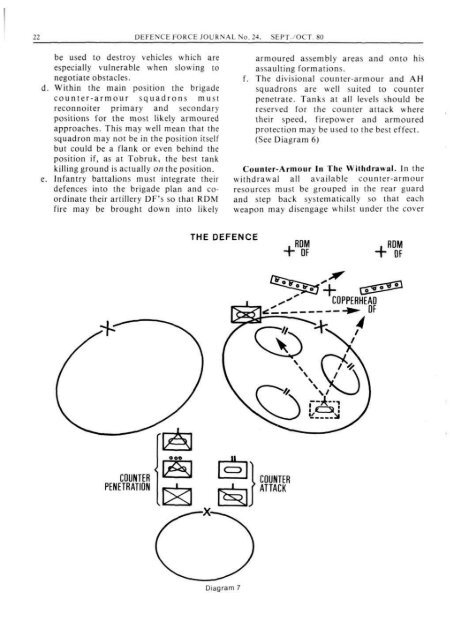ISSUE 24 : Sep/Oct - 1980 - Australian Defence Force Journal
ISSUE 24 : Sep/Oct - 1980 - Australian Defence Force Journal
ISSUE 24 : Sep/Oct - 1980 - Australian Defence Force Journal
- No tags were found...
Create successful ePaper yourself
Turn your PDF publications into a flip-book with our unique Google optimized e-Paper software.
22 DEFENCE FORCE JOURNAL No. <strong>24</strong>. SEPT. OCT. 80be used to destroy vehicles which areespecially vulnerable when slowing tonegotiate obstacles.Within the main position the brigadecounter-armour squadrons mustreconnoiter primary and secondarypositions for the most likely armouredapproaches. This may well mean that thesquadron may not be in the position itselfbut could be a flank or even behind theposition if, as at Tobruk, the best tankkilling ground is actually on the position.Infantry battalions must integrate theirdefences into the brigade plan and coordinatetheir artillery DF's so that RDMfire may be brought down into likelyarmoured assembly areas and onto hisassaulting formations.The divisional counter-armour and AHsquadrons are well suited to counterpenetrate. Tanks at all levels should bereserved for the counter attack wheretheir speed, firepower and armouredprotection may be used to the best effect.(See Diagram 6)Counter-Armour In The Withdrawal. In thewithdrawal all available counter-armourresources must be grouped in the rear guardand step back systematically so that eachweapon may disengage whilst under the coverTHE DEFENCE, RDM+ DF. RDMT DF^ 5 5 ^ ^&OZ&COPPERHEADOFCOUNTERPENETRATIONm |£|COUNTERATTACKDiagram 7

















